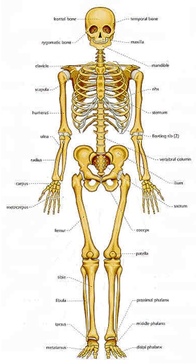 "Don't bend at the waist. Bend your knees and keep your back straight. Don't bend forward at the waist with your knees straight. Don't bend and twist." Is this medical "wisdom"? Many sources with very impressive strings of credentials herald these words. At The POSTURE Clinic we think differently. We always ask why and we are always treating the cause not the symptoms. WHY not bend at the waist? Someone in a white coat came up with the idea, that's why. If someone hurt their back bending from the waist, then all bending at the waist is dangerous to health? Maybe poor posture is pandemic due to too much sitting, the technology age and reduction in activity. Maybe humans have lost their proper muscle balance and skeletal alignment. In the picture to the right, do you see an asymmetrical human body? Do you see one leg positioned differently than the other? Is one foot turning out to the side, like a duck or turning inward like a pigeon? Is the shoulder girdle slanted and unlevel? Is the pelvis tipping up on one side higher than the other side? If you answered NO to all of these questions, congratulations you are right.  In the picture to the left, do you see a flattened low back curve or a straight spine or the tail bone tucked under the body or the head forward out in space? If you said NO you are correct. The diagram to the left illustrates the proper shape of the spine and proper position of the pelvis, head and proper position of the whole body from the side view. Everyone (except 5% of the population) is born with this design position. Over time muscle imbalances develop then the design position is lost. The deviation is not permanent nor is it OK. The design to the left is the most efficient effective way to be in gravity. It produces very little friction and no wear and tear from this position and allows full function. 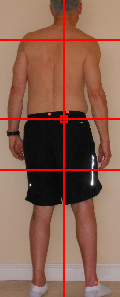 Are his load bearing joints lined up vertically and horizontally? Has he maintained his optimal design position? NO. Do you think the belief "don't bend at the waist" resulted from people with bad misaligned posture like this person bending at the waist using a misaligned crooked body and getting injured? Then why not promote proper posture and muscle balance and alignment instead of focusing on limiting movement MORE (by "not bending the back or waste)! The spine, muscles, joints and the whole body for that matter are not fragile. They are only ripe for injury and therefore vulnerable when misaligned. IF YOUR JOINTS ARE NOT LINED UP AND PELVIS not level AND SPINE NOT STRAIGHT THEN YES, BEND OVER AND YOU might have pain or injury. If this person to the left bent over at the waist without using his knees what percentage chance does he have of injury? If you said, "pretty high' or "a lot" - you are right. If our primary load-bearing joints are not stacked properly, if the spine looses it's original curves and functioning as designed, you bet, there is a much greater chance of injury including back injury. 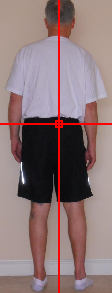 Here is the same man. Now what do you think? Does he have a pretty good chance of no back injury bending at the waist? If you said yes, then you are right. In this position, his joints, muscles, tendons, ligaments and bones are much more balanced and therefore can function without injury. NEW BELIEF #2: A properly aligned posture is a functionally strong posture which allows bending at the waist. 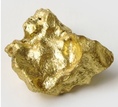 THE GOLDEN NUGGET: Here is the take away message. If your load bearing joints are not stacked and functioning properly, if the curves of your spine have changed, either flattened or become exaggerated or produced other curves, then bending over from the waist could be disasterous. If your load bearing joints are stacked and functioning properly, you can bend and twist and be free of injury. You can live life without previous limitations. You won't have to live in fear. If you do your work to get yourself back in proper body alignment and work closely with your Posture Therapist, you can be free to move without the threat of injury and limitations. It takes dedication and hard work, but in the end the peace of mind will be worth it. Come in for a consultation and your Posture Photos and see how your Posture is connected to your pain and what you can do about it. Catee Ingwersen is a Posture Alignment Specialist trained, certified by the Egoscue University in The Egoscue® Method. She empowers people every day to overcome pain and physical limitations unlike any other healing or medical intervention. Call 772-559-1532 or stop by our Clinic in Vero Beach, Florida to discuss this common sense approach and your individual needs.
0 Comments
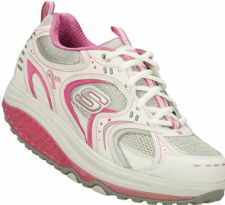 Your body is an amazingly resilient natural movement machine. It's design and function has been around for a very LONG LONG time. When our bodies do things we don't understand, produce changes that make us anxious, nervous or fearful, what do we do? We rely on the beliefs we've acquired. Where did we get the beliefs? Usually they are acquired from family or friends, electronic and print media, or "experts". Oftentimes these beliefs aren't questioned or examined. They are taken for granted. Sometimes we discover that long held beliefs no longer serve us. As this discussion relates to the human body and specifically the musculoskeletal system, we may follow advice and discover later that perhaps it wasn't in our best interest. Here is an outdated belief concerning shoes that we will reexamine, question and replace: Outdated Belief: "Always wear supportive shoes, avoid going barefoot. The foot is a movement machine. How could your body move from point A to point B without feet? It couldn't. Mechanically, when you walk there is a complex series of components of movement your foot, ankle, knee, hip and shoulders (YES! shoulders too) goes through. This is called the Gait Cycle. Thinking about your foot for a moment, when you are walking (or "in Gait") your Heel should strike the ground in the Heel's rear center edge. As your leg and body moves over and above the heel, the next part to make ground contact is the Center aspect of your foot. You should not be using exclusively the inner or outer edge of the middle section of your foot. Weight is then transferred to the Ball and then all toes with which you push off with. You should not be putting pressure exclusively or pushing off only with your big or little toe. Shoes MUST allow the foot and ankle to make all these Gait movements sequentially, correctly, fully and freely. Further and as important, the foot is also getting important information about the terrain and sending messages neurologically to the brain about it. The brain sends neurological signals back to certain muscles of the foot, low leg, upper leg etc to manage navigation of the contours of whatever is underfoot. When the foot is encased in rigid immoveable shoes so is the foot and the associated muscles. All rocker bottom or rigid shoes do not allow the foot to bend nor do they allow the foot to "read" the terrain. People with foot problems like these shoes since they do seem to help "quiet" the symptoms but they never resolve the real underlying problem for the bunion or hammer toes or plantar fasciitis etc. 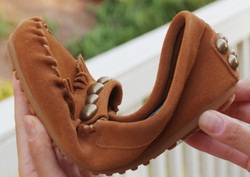 Feet are sending neurological messages to the brain about the ground and the brain replies back sending nerve messages to the muscles of the feet and legs to adjust accordingly for changes in terrain etc. Hard inflexible shoes, shoes with anything but flat flexible bottoms are cutting off that entire process. Put mittens on and go about your day trying to feel anything and operate like that. A week of that and the hands and fingers are pretty stiff from not being able to move freely. The stiff sole makes the muscles of the feet very stiff and possibly atrophy and the ankle is not required to move very much. That affects the rest of the body and makes injury likely. With stiff, inflexible shoes this important feedback mechanism is impossible. New Belief to Replace Old Belief: "Wear shoes allowing the same amount of foot and toe movement as the foot could make without shoes. Go barefoot whenever possible." The bottom line is: Almost all shoes ENCASE or trap the foot and do not allow for freedom of proper functional movement required that must occur. A stiff shoe, stiff orthotics that can not bend JUST LIKE the foot bends will cause the muscles of the foot to weaken and in some cases to become very tight and immobile. This can change the gait mechanics which will effect all the other load bearing joints in the body: ankle knee, hip, shoulder. What type of shoes should you wear? Hold one of your shoes, the heel in one hand and the toe in the other hand. Now bend the shoes in half. Now twist it like you're wringing out a towel. If it's very easy to bend, twist and is supple, that's good. Your foot will be supple and easy to move and bend. If you can not bend or twist your shoe, neither will your foot. Donate them to charity. 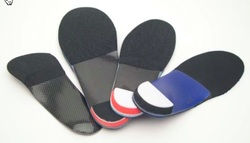 Orthotics over time will weaken the arch of the foot as orthotics are stiff and merely serving as a temporary prop. The orthotic props up the arch while you are using them but when you aren't the arches collapse. Essentially they are propping up the dysfunction- actually supporting the dysfunction. This solves nothing. Ultimately, you will have a weaker arch and foot. When the Posture is not aligned properly the various muscles groups holding the joints and bones stable no longer have equal tension front to back and side to side. This can reposition any part of the body, put pressure on organs, create friction in any joint and will set up the body for injury. Some muscles will become unable to fully do their job and other muscles will have to chip in to help. Any of these and other scenarios can occur which can create mechanical problems for the foot, the arches and ankle function. If you have foot pain, pain going barefoot, bunions, hammertoes, plantar fasciitis and other foot problems there is a great likelihood the muscle tension and mechanics of other joints up the line are to blame. Dr. Gangemi, chiropractor in North Carolina writes an interesting article about Flat Feet, orthotics and shoes which we couldn't agree more with: "There should be little to no cushion or padding in the sole, and the shoe should not be rigid anywhere – it should bend throughout the shoe and in any direction. The shoe should also be wide at the toe box allowing the toes to naturally splay apart. Standing and walking barefoot are two easy ways to start treating flat feet naturally. ... barefoot is the ultimate way to naturally and most effectively strengthen the muscles, tendons, and ligaments of the lower leg and foot." We are advocates of helping you understand as much as you can about your own body so you can make your own INFORMED decisions. Specifically, being informed and understanding the musculoskeletal system is not hard nor complicated, unless we make it. We are here to help clients discover that the real causes of their pain and musculoskeletal dysfunction are usually not where their symptoms are. We have been working with thousands of people to help them understand their muscles and body and to resolve their pain. The answer is not to shut down the body's only voice-- pain. The answer lies in looking upstream to see where the REAL CAUSES are - the dysfunctional muscles - and to get them back working again so the whole body can be balanced without friction, wear and tear or from progressively shutting down body functions with Gimmicks. Give us a call we'll show you what is causing your foot and ankle problems. If you'd like to understand your body and resolve your pain please give us a call. The POSTURE Clinic: 772-559-1532 |
AuthorCatee Ingwersen is an Egoscue certified Posture Alignment Specialist and Licensed Massage Therapist. Archives
June 2018
Categories
All
|
 RSS Feed
RSS Feed